Unit 1 Period 1 Welcome to the unit 课件+嵌入音频 (共24张PPT)
文档属性
| 名称 | Unit 1 Period 1 Welcome to the unit 课件+嵌入音频 (共24张PPT) | 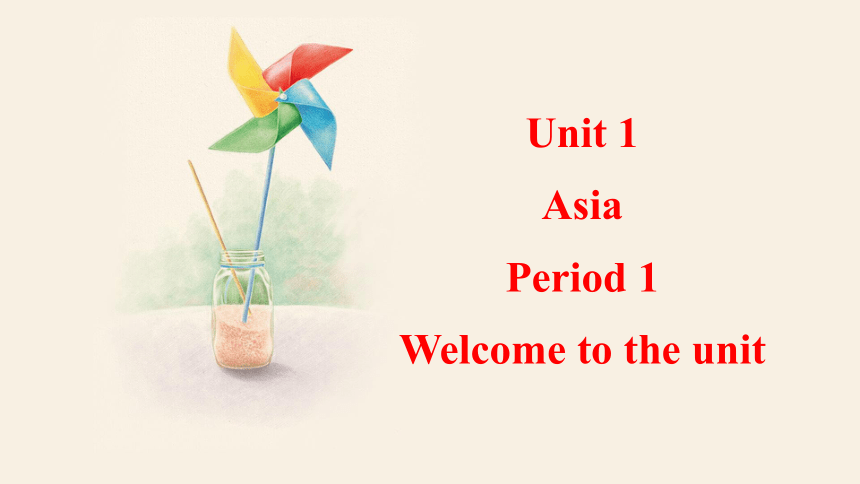 | |
| 格式 | pptx | ||
| 文件大小 | 6.2MB | ||
| 资源类型 | 教案 | ||
| 版本资源 | 牛津译林版 | ||
| 科目 | 英语 | ||
| 更新时间 | 2023-12-29 16:31:27 | ||
图片预览


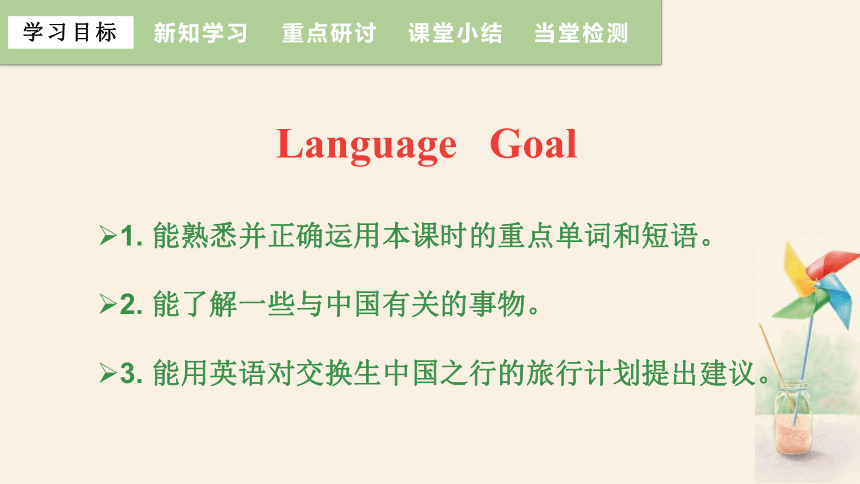
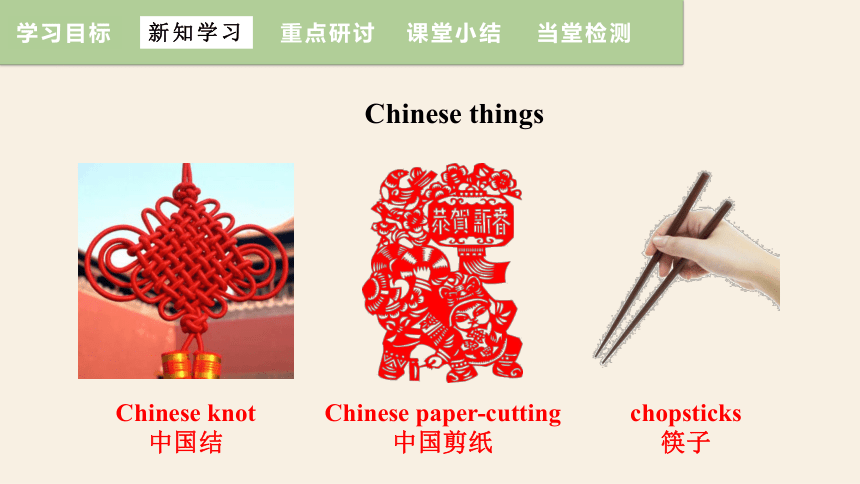
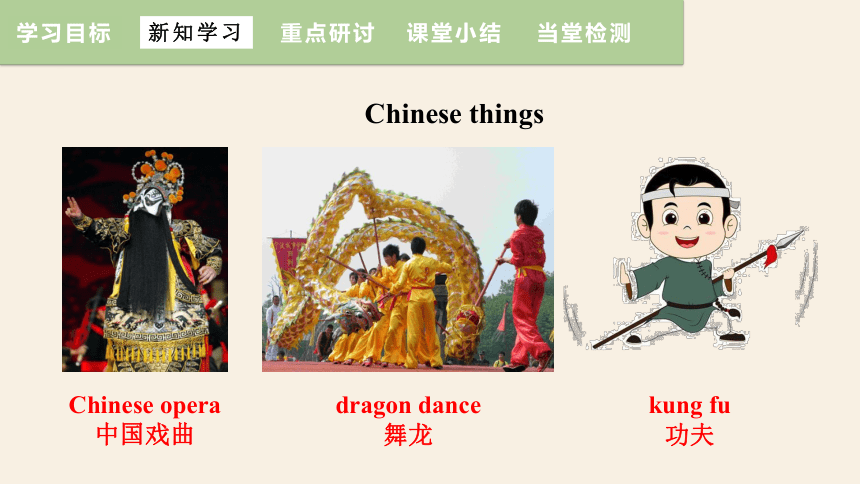
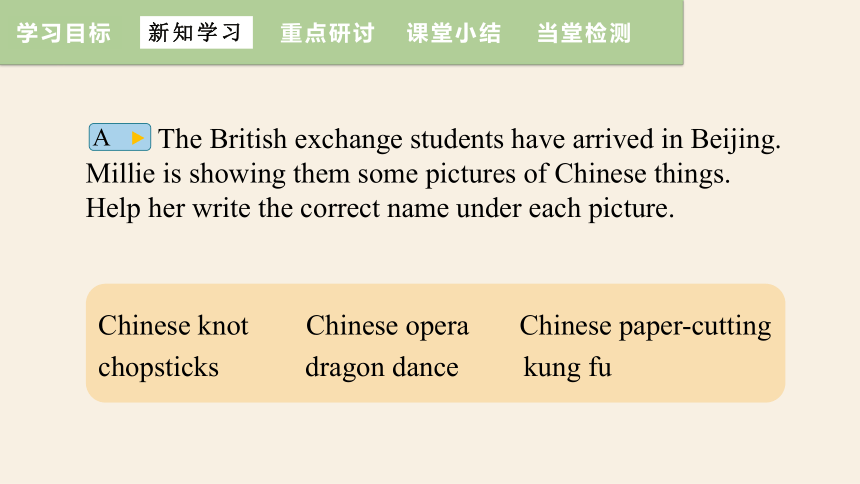
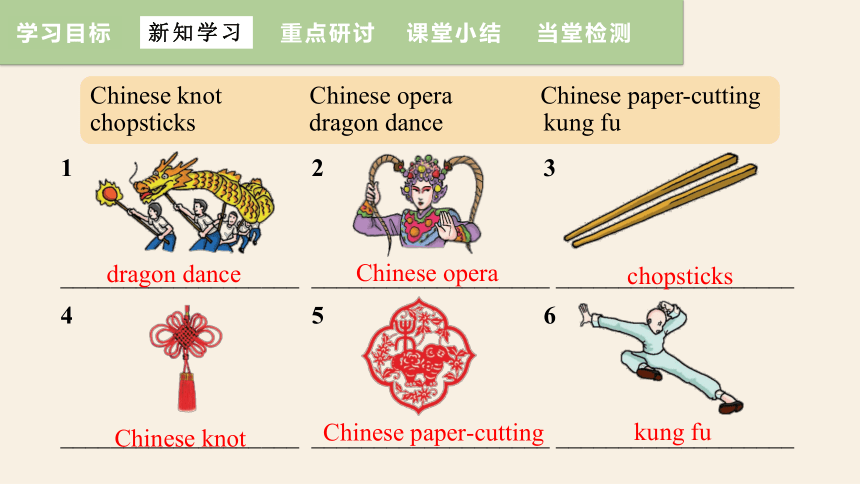
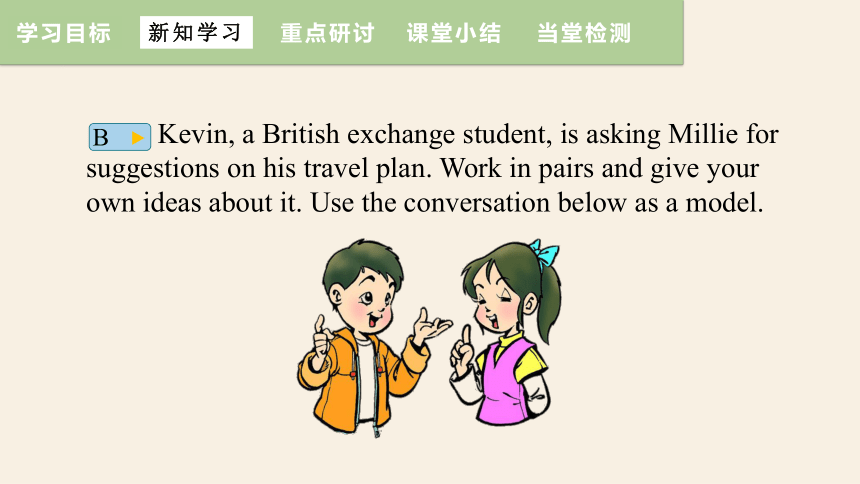
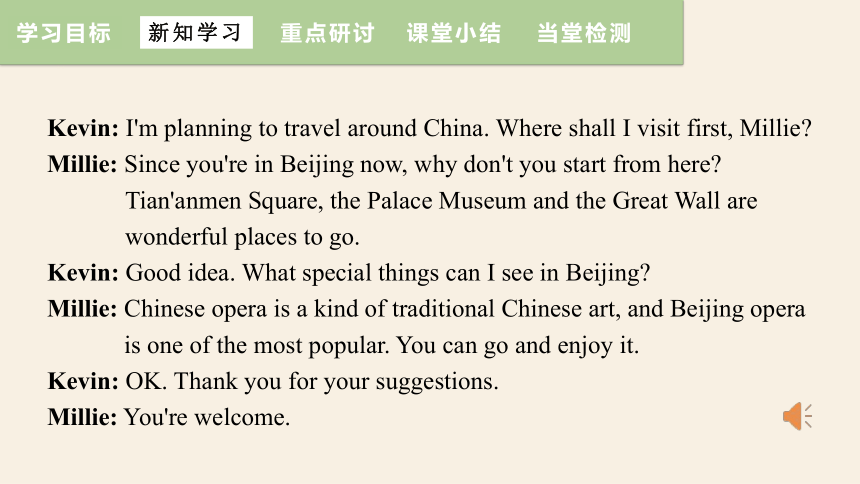
文档简介
(共24张PPT)
Unit 1
Asia
Period 1
Welcome to the unit
新
课
导
入
Free Talk
When it comes to China, what things will you think of
Language Goal
新知学习
课堂小结
当堂检测
学习目标
重点研讨
1. 能熟悉并正确运用本课时的重点单词和短语。
2. 能了解一些与中国有关的事物。
3. 能用英语对交换生中国之行的旅行计划提出建议。
新知学习
课堂小结
当堂检测
学习目标
重点研讨
Chinese things
Chinese knot 中国结
Chinese paper-cutting 中国剪纸
chopsticks 筷子
新知学习
课堂小结
当堂检测
学习目标
重点研讨
Chinese things
Chinese opera 中国戏曲
dragon dance 舞龙
kung fu 功夫
新知学习
课堂小结
当堂检测
学习目标
重点研讨
The British exchange students have arrived in Beijing. Millie is showing them some pictures of Chinese things. Help her write the correct name under each picture.
A
▲
Chinese knot Chinese opera Chinese paper-cutting chopsticks dragon dance kung fu
新知学习
课堂小结
当堂检测
学习目标
重点研讨
Chinese knot Chinese opera Chinese paper-cutting chopsticks dragon dance kung fu
___________________ ___________________ ___________________
___________________ ___________________ ___________________
1 2 3
4 5 6
dragon dance
Chinese opera
chopsticks
Chinese knot
Chinese paper-cutting
kung fu
新知学习
课堂小结
当堂检测
学习目标
重点研讨
Kevin, a British exchange student, is asking Millie for suggestions on his travel plan. Work in pairs and give your own ideas about it. Use the conversation below as a model.
B
▲
新知学习
课堂小结
当堂检测
学习目标
重点研讨
Kevin: I'm planning to travel around China. Where shall I visit first, Millie
Millie: Since you're in Beijing now, why don't you start from here Tian'anmen Square, the Palace Museum and the Great Wall are wonderful places to go.
Kevin: Good idea. What special things can I see in Beijing
Millie: Chinese opera is a kind of traditional Chinese art, and Beijing opera is one of the most popular. You can go and enjoy it.
Kevin: OK. Thank you for your suggestions.
Millie: You're welcome.
新知学习
课堂小结
当堂检测
学习目标
重点研讨
Read the conversation and answer the questions below.
1. Which city does Millie advise Kevin to visit first
2. Which wonderful places can Kevin go
3. What special things can Kevin see
Beijing.
Tian'anmen Square, the Palace Museum and the Great Wall.
Chinese opera, especially Beijing opera.
新知学习
课堂小结
当堂检测
学习目标
重点研讨
Wow, the Great Wall is amazing, isn't it
No, it isn't. It's tiring to climb the steps, and my feet hurt. I'm taking a rest.
新知学习
课堂小结
当堂检测
学习目标
重点研讨
No, Eddie! There's still a long way to go. We'd better keep moving.
I don't want to go on, Hobo. Wake me up on your way back.
新知学习
课堂小结
当堂检测
学习目标
重点研讨
Fill in the blanks.
One day, Hobo and Eddie ________ the Great Wall. Hobo thought it was ________ to climb the Great Wall, but Eddie felt very ______. Hobo encouraged Eddie to keep _______, but Eddie decided to _______ a rest.
climbed
amazing
tired
moving
take
新知学习
课堂小结
当堂检测
学习目标
重点研讨
Pair Work
Work in pairs and act it out.
Language Points
新知学习
课堂小结
当堂检测
学习目标
重点研讨
1. Wow, the Great Wall is amazing, isn't it
哇,长城真壮观啊,不是吗?
本句是反意疑问句。用来征求对方的看法。
这种疑问句有两部分组成,前一部分是陈述句,后一部分是附加问句,中间用逗号隔开。附加问句一般由 “系动词be/ 助动词/ 情态动词+代词”构成。两部分的人称、时态应保持一致。
e.g. He likes cats, doesn't he 他喜欢猫,不是吗?
This isn't your book, is it 这不是你的书,是吗?
新知学习
课堂小结
当堂检测
学习目标
重点研讨
(1) 两种形式:a. 前肯定,后否定 ;b. 前否定,后肯定:
e.g. —He is your teacher, isn't he 他是你的老师,不是吗?
—Yes, he is. 是的,他是。/ No, he isn't. 不,他不是。
—Li Ming can't swim, can he 李明不会游泳,是吗?
—Yes, he can. 不,他会。/ No, he can't. 是的,他不会。
(2) 答语:反意疑问句也用yes或no作答,事实是肯定的就用yes,事实是否定的就用no。
e.g. Let's meet at the airport, shall we
咱们在机场见,可以吗?
Have a little more wine, will you
再喝点儿酒,可以吗?
新知学习
课堂小结
当堂检测
学习目标
重点研讨
(3) 陈述部分为祈使句:陈述部分若是Let's开头的祈使句,其附加问句为shall we;不是以Let's开头的,附加问句都可用will you。
新知学习
课堂小结
当堂检测
学习目标
重点研讨
2. I'm taking a rest. 我要休息一下。
文中的I'm taking a rest. 是用现在进行时表示即将进行的安排,即说话的时刻之前已经决定了的安排。英语中的一些动词如come、go、stay、leave、arrive、fly、walk、drive、ride、take等,常用现在进行时表示确切的计划或已安排好的活动。
e.g. I am planning to travel around China. 我打算在中国旅行。
We are leaving for Japan soon. 我们马上前往日本。
新知学习
课堂小结
当堂检测
学习目标
重点研讨
3. We'd better keep moving. 我们最好坚持走。
had better do sth. 最好做某事 had better后接动词的原形
e.g. I'd better finish my homework before mom gets home. 我最好在妈妈到家前完成家庭作业。
keep doing sth. 坚持做某事,一直做某事
e.g. He kept talking until the meeting was over.
他一直在说,直到会议结束。
e.g. After a short rest, they went on working.
短暂休息之后,他们继续工作。
新知学习
课堂小结
当堂检测
学习目标
重点研讨
4. I don't want to go on, Hobo. 霍波,我不想继续了。
go on doing sth. 指继续做同一件事。
e.g. After a short rest, they went on with the work. 短暂休息之后,他们继续那项工作。
go on with sth. 指继续同一件事,此时with后能接名词,代词,不能跟ing形式。
e.g. After finishing the words, they went on to go over the text.
写完单词后,他们继续复习课文。
go on to do sth. 指接着做另外一件事。
e.g. Stop shouting or you'll wake up the neighbors.
别喊了,不然你会把邻居吵醒的。
Please wake me up at 6:00 a.m. 请在早上6点叫醒我。
新知学习
课堂小结
当堂检测
学习目标
重点研讨
5. Wake me up on your way back. 在你回来的路上叫醒我。
①叫醒。是“动词+副词”结构的短语, 若宾语是名词,可放在up后面,也可放在wake与up中;若宾语是人称代词,则只能放在wake和up中间。
e.g. I often wake up at 6:00 a.m. 我常在早上6点醒来。
②醒来。表示自行醒来,后不接宾语。
新知学习
重点研讨
课堂小结
当堂检测
学习目标
Unit 1
Period 1
与中国有关的事物:
Chinese knot ___________
Chinese opera ___________
Chinese paper-cutting ___________
chopsticks ___________
dragon dance ___________
kung fu ___________
重点单词和短语:
tiring, step, Chinese knot, Chinese opera, Chinese paper-cutting, chopsticks, dragon dance, had better, go on
中国结
中国戏曲
中国剪纸
筷子
舞龙
功夫
1. We are going to watch the ___________ (舞龙) this afternoon.
2. You should learn to use ___________ (筷子).
3. It's rather ___________ (累人的) to work late every day.
4. It's hard for old people to climb so many ___________ (台阶).
5. If we ___________ (继续) to destroy forests to build roads, animals won't have suitable homes.
新知学习
课堂小结
当堂检测
学习目标
重点研讨
一、根据句意及提示完成下列句子。
dragon dance
chopsticks
tiring
steps
go on
新知学习
课堂小结
当堂检测
学习目标
重点研讨
二、用所给单词的适当形式填空。
1. You'd better __________ (return) the book at once.
2. He kept __________ (cough) all morning.
3. She __________ (be) one of the best singers in the world.
4. Why don't you __________ (go) out for a walk
5. There is little juice in the glass, __________ (be) there
return
coughing
is
go
is
Unit 1
Asia
Period 1
Welcome to the unit
新
课
导
入
Free Talk
When it comes to China, what things will you think of
Language Goal
新知学习
课堂小结
当堂检测
学习目标
重点研讨
1. 能熟悉并正确运用本课时的重点单词和短语。
2. 能了解一些与中国有关的事物。
3. 能用英语对交换生中国之行的旅行计划提出建议。
新知学习
课堂小结
当堂检测
学习目标
重点研讨
Chinese things
Chinese knot 中国结
Chinese paper-cutting 中国剪纸
chopsticks 筷子
新知学习
课堂小结
当堂检测
学习目标
重点研讨
Chinese things
Chinese opera 中国戏曲
dragon dance 舞龙
kung fu 功夫
新知学习
课堂小结
当堂检测
学习目标
重点研讨
The British exchange students have arrived in Beijing. Millie is showing them some pictures of Chinese things. Help her write the correct name under each picture.
A
▲
Chinese knot Chinese opera Chinese paper-cutting chopsticks dragon dance kung fu
新知学习
课堂小结
当堂检测
学习目标
重点研讨
Chinese knot Chinese opera Chinese paper-cutting chopsticks dragon dance kung fu
___________________ ___________________ ___________________
___________________ ___________________ ___________________
1 2 3
4 5 6
dragon dance
Chinese opera
chopsticks
Chinese knot
Chinese paper-cutting
kung fu
新知学习
课堂小结
当堂检测
学习目标
重点研讨
Kevin, a British exchange student, is asking Millie for suggestions on his travel plan. Work in pairs and give your own ideas about it. Use the conversation below as a model.
B
▲
新知学习
课堂小结
当堂检测
学习目标
重点研讨
Kevin: I'm planning to travel around China. Where shall I visit first, Millie
Millie: Since you're in Beijing now, why don't you start from here Tian'anmen Square, the Palace Museum and the Great Wall are wonderful places to go.
Kevin: Good idea. What special things can I see in Beijing
Millie: Chinese opera is a kind of traditional Chinese art, and Beijing opera is one of the most popular. You can go and enjoy it.
Kevin: OK. Thank you for your suggestions.
Millie: You're welcome.
新知学习
课堂小结
当堂检测
学习目标
重点研讨
Read the conversation and answer the questions below.
1. Which city does Millie advise Kevin to visit first
2. Which wonderful places can Kevin go
3. What special things can Kevin see
Beijing.
Tian'anmen Square, the Palace Museum and the Great Wall.
Chinese opera, especially Beijing opera.
新知学习
课堂小结
当堂检测
学习目标
重点研讨
Wow, the Great Wall is amazing, isn't it
No, it isn't. It's tiring to climb the steps, and my feet hurt. I'm taking a rest.
新知学习
课堂小结
当堂检测
学习目标
重点研讨
No, Eddie! There's still a long way to go. We'd better keep moving.
I don't want to go on, Hobo. Wake me up on your way back.
新知学习
课堂小结
当堂检测
学习目标
重点研讨
Fill in the blanks.
One day, Hobo and Eddie ________ the Great Wall. Hobo thought it was ________ to climb the Great Wall, but Eddie felt very ______. Hobo encouraged Eddie to keep _______, but Eddie decided to _______ a rest.
climbed
amazing
tired
moving
take
新知学习
课堂小结
当堂检测
学习目标
重点研讨
Pair Work
Work in pairs and act it out.
Language Points
新知学习
课堂小结
当堂检测
学习目标
重点研讨
1. Wow, the Great Wall is amazing, isn't it
哇,长城真壮观啊,不是吗?
本句是反意疑问句。用来征求对方的看法。
这种疑问句有两部分组成,前一部分是陈述句,后一部分是附加问句,中间用逗号隔开。附加问句一般由 “系动词be/ 助动词/ 情态动词+代词”构成。两部分的人称、时态应保持一致。
e.g. He likes cats, doesn't he 他喜欢猫,不是吗?
This isn't your book, is it 这不是你的书,是吗?
新知学习
课堂小结
当堂检测
学习目标
重点研讨
(1) 两种形式:a. 前肯定,后否定 ;b. 前否定,后肯定:
e.g. —He is your teacher, isn't he 他是你的老师,不是吗?
—Yes, he is. 是的,他是。/ No, he isn't. 不,他不是。
—Li Ming can't swim, can he 李明不会游泳,是吗?
—Yes, he can. 不,他会。/ No, he can't. 是的,他不会。
(2) 答语:反意疑问句也用yes或no作答,事实是肯定的就用yes,事实是否定的就用no。
e.g. Let's meet at the airport, shall we
咱们在机场见,可以吗?
Have a little more wine, will you
再喝点儿酒,可以吗?
新知学习
课堂小结
当堂检测
学习目标
重点研讨
(3) 陈述部分为祈使句:陈述部分若是Let's开头的祈使句,其附加问句为shall we;不是以Let's开头的,附加问句都可用will you。
新知学习
课堂小结
当堂检测
学习目标
重点研讨
2. I'm taking a rest. 我要休息一下。
文中的I'm taking a rest. 是用现在进行时表示即将进行的安排,即说话的时刻之前已经决定了的安排。英语中的一些动词如come、go、stay、leave、arrive、fly、walk、drive、ride、take等,常用现在进行时表示确切的计划或已安排好的活动。
e.g. I am planning to travel around China. 我打算在中国旅行。
We are leaving for Japan soon. 我们马上前往日本。
新知学习
课堂小结
当堂检测
学习目标
重点研讨
3. We'd better keep moving. 我们最好坚持走。
had better do sth. 最好做某事 had better后接动词的原形
e.g. I'd better finish my homework before mom gets home. 我最好在妈妈到家前完成家庭作业。
keep doing sth. 坚持做某事,一直做某事
e.g. He kept talking until the meeting was over.
他一直在说,直到会议结束。
e.g. After a short rest, they went on working.
短暂休息之后,他们继续工作。
新知学习
课堂小结
当堂检测
学习目标
重点研讨
4. I don't want to go on, Hobo. 霍波,我不想继续了。
go on doing sth. 指继续做同一件事。
e.g. After a short rest, they went on with the work. 短暂休息之后,他们继续那项工作。
go on with sth. 指继续同一件事,此时with后能接名词,代词,不能跟ing形式。
e.g. After finishing the words, they went on to go over the text.
写完单词后,他们继续复习课文。
go on to do sth. 指接着做另外一件事。
e.g. Stop shouting or you'll wake up the neighbors.
别喊了,不然你会把邻居吵醒的。
Please wake me up at 6:00 a.m. 请在早上6点叫醒我。
新知学习
课堂小结
当堂检测
学习目标
重点研讨
5. Wake me up on your way back. 在你回来的路上叫醒我。
①叫醒。是“动词+副词”结构的短语, 若宾语是名词,可放在up后面,也可放在wake与up中;若宾语是人称代词,则只能放在wake和up中间。
e.g. I often wake up at 6:00 a.m. 我常在早上6点醒来。
②醒来。表示自行醒来,后不接宾语。
新知学习
重点研讨
课堂小结
当堂检测
学习目标
Unit 1
Period 1
与中国有关的事物:
Chinese knot ___________
Chinese opera ___________
Chinese paper-cutting ___________
chopsticks ___________
dragon dance ___________
kung fu ___________
重点单词和短语:
tiring, step, Chinese knot, Chinese opera, Chinese paper-cutting, chopsticks, dragon dance, had better, go on
中国结
中国戏曲
中国剪纸
筷子
舞龙
功夫
1. We are going to watch the ___________ (舞龙) this afternoon.
2. You should learn to use ___________ (筷子).
3. It's rather ___________ (累人的) to work late every day.
4. It's hard for old people to climb so many ___________ (台阶).
5. If we ___________ (继续) to destroy forests to build roads, animals won't have suitable homes.
新知学习
课堂小结
当堂检测
学习目标
重点研讨
一、根据句意及提示完成下列句子。
dragon dance
chopsticks
tiring
steps
go on
新知学习
课堂小结
当堂检测
学习目标
重点研讨
二、用所给单词的适当形式填空。
1. You'd better __________ (return) the book at once.
2. He kept __________ (cough) all morning.
3. She __________ (be) one of the best singers in the world.
4. Why don't you __________ (go) out for a walk
5. There is little juice in the glass, __________ (be) there
return
coughing
is
go
is
